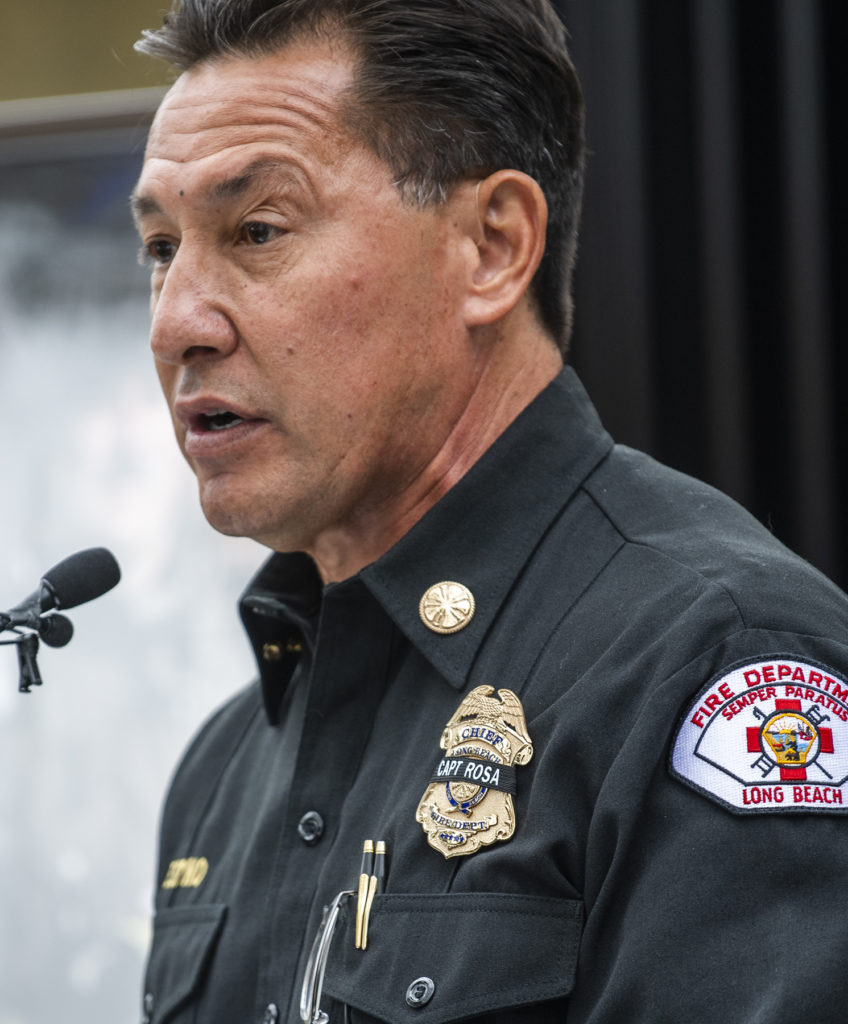In a city with a population that’s almost 13 percent African-American, there’s not a single black woman working as a firefighter in Long Beach.
Of the Long Beach Fire Department’s 389 firefighters, only 15 are women of any race.
And despite serving a majority-minority city, the LBFD’s workforce is still 63% white.
Those are a few stats cited in a recent report outlining the state of the LBFD’s workforce and how the department’s new chief plans to make it more diverse.
“It’s important to us because it would make us more reflective of the community that we serve, the residents and the visitors that come here to Long Beach,” said Chief Xavier Espino, who got the job in October. “It actually makes us stronger as a department by having a diverse workforce, both ethnicity and gender.”
| Ethnicity | Male | Female | Total |
| Asian | 10% | 0.3% | 10% |
| Black | 8.5% | 0% | 8% |
| Hispanic/Latino | 18% | 0.8% | 19% |
| Native American | 0.5% | 0% | 0% |
| White | 59.1% | 3.8% | 63% |
| Total | 374 | 15 | 389 |
The report, which Espino sent to the Long Beach City Council on Tuesday, details programs the LBFD already has in place to mold its workforce, but he says more needs to be done.
The LBFD is more racially diverse than the average fire agency, his report notes, but it still falls short of representing Long Beach, whose population of white residents has dwindled to 27.6% as the number of Latino and Asian residents has risen.
Espino said he’s seen firsthand the benefits of embracing new cultures on the fire engine. In the late ‘80s, he worked as a paramedic in West Long Beach where his bilingualism was a boon.
“You would see Hispanic folks relax as someone that looked like them came in the room and could speak a language that they understood,” he said.
An ideal LBFD workforce would be one that looks like Long Beach, Espino said.
| Ethnicity | Total |
| Asian | 13.2% |
| Black | 12.9% |
| Hispanic/Latino | 42.8% |
| Native American | 1.2% |
| White | 27.6% |
| Total | 464,000 |
The chief’s report lays out a dozen strategies to move toward that end.
Some of them are simple:
- Reworking the department’s social media strategy and updating its website with pictures of firefighters from underrepresented communities.
But many of the tactics are more in-depth:
- Espino wants all staffers involved in hiring to undergo implicit bias training, a process designed to help them recognize stereotypes and biased attitudes that can creep in unconsciously.
- By next year, he plans to create an open mentorship program designed to reach applicants who don’t have the benefit of previous family or social ties with firefighters.
- A partnership with Long Beach City College is also in the works to create a day-long event encouraging women to join the fire service by featuring female firefighters and giving anyone, male or female, a chance to practice for the LBFD’s physical ability test.
- Some of the suggestions take aim at specific disparities. For instance, in the last four classes of recruits, female applicants and black applicants have tended to score measurably worse on a test the department uses to evaluate applicants’ mechanical aptitude, math skills, reading level and human relational ability. Espino’s report proposes investigating alternatives to that test.
Espino is Long Beach’s first Latino fire chief. His elevation may be part of a trend that’s also showing in the department’s rank-and-file.

Over the last six years, the number of Latino applicants to the department have steadily risen. They’re now roughly equal with the number of white applicants, with each category making up a little over 35% of the total.
But the number of applicants from other underrepresented groups have remained stubbornly low and—in some cases—moved backward, according to the report.
In 2014, 15% of applicants were black, but that dwindled to 8% this year.
But the widest disparity is in gender. Only about 5% of applicants since 2014 have been female, according to the report.
This isn’t out of step with national averages. Only 7% of firefighters across the country are female, according to the nonprofit National Fire Protection Association. That percentage drops to 4% when you remove volunteer firefighters from the equation.
| Ethnicity | Total |
| Asian | 1% |
| Black | 9% |
| Hispanic/Latino | 8.3% |
| Native American | 0% |
| White | 81.8% |
Long Beach has a recent history with sex discrimination allegations at the department. In 2013 the city settled with a group of female firefighters who sued over equal access to facilities.
They said they were relegated to changing in the hallway or waiting to shower off blood and feces after calls while their male coworkers used the bathrooms and locker rooms.
As part of the settlement, the city agreed to retrofit its stations with adequate facilities for female firefighters, according to the Orange County Register.
One of the women who sued, Karen Rindone, has since been promoted through the LBFD’s ranks. Earlier this year, she became the department’s first female battalion chief. In a statement at the time, she said the process that led up to that promotion was “long, strenuous, and fair.”
Espino held Rindone up as an example of the department’s current attitude and opportunities for women. He said he plans to meet with all the department’s female firefighters to talk with them about pathways to promotion.
If he were pitching a woman on a career at the LBFD, Espino said he can confidently tell her she would be given the same opportunities and advantages as any male candidate.
“I truly believe that,” he said.

